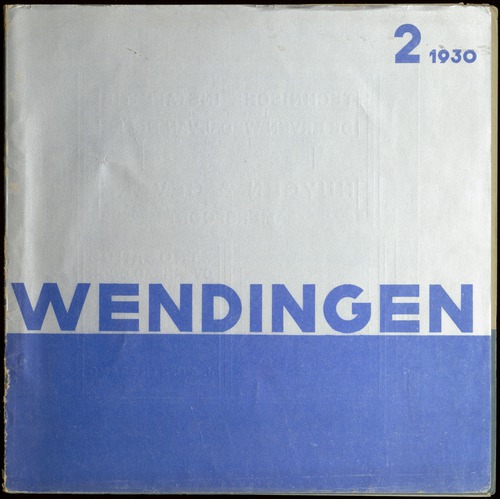Wendingen on:
[Wikipedia]
[Google]
[Amazon]





 ''Wendingen'' (
''Wendingen'' (
Wendingen
Digital Magazines IADDB. See also Periodicals: Wendingen Dutch, English, French, German. (Publication date, not date in magazine).
Wendingen
Dutch digital platform
Het maandblad ''Wendingen'' (Website ZuidelijkeWandelweg.nl)
{{Authority control 1918 establishments in the Netherlands 1932 disestablishments in the Netherlands Defunct architecture magazines Defunct magazines published in the Netherlands Monthly magazines published in the Netherlands Defunct Dutch-language magazines Magazines established in 1918 Magazines disestablished in 1932 Magazines published in Amsterdam Defunct design magazines





 ''Wendingen'' (
''Wendingen'' (Dutch
Dutch or Nederlands commonly refers to:
* Something of, from, or related to the Netherlands
** Dutch people as an ethnic group ()
** Dutch nationality law, history and regulations of Dutch citizenship ()
** Dutch language ()
* In specific terms, i ...
: ''Inversion'' or ''Upheaval'', literally ''turns'') was an architecture and art magazine that appeared from 1918 to 1932. It was a monthly publication aimed at architects and interior designers. The booklet was published by Amsterdam publisher Hooge Brug (1918–1923) and by the Santpoort publisher C.A. Mees (1924–1931). It was a mouthpiece for the architect association Architectura et Amicitia. (Architecture and Friendship). The chief editor was the architect Hendricus Theodorus Wijdeveld. Wendingen initially was an important platform for Dutch expressionism
Expressionism is a modernist movement, initially in poetry and painting, originating in Northern Europe around the beginning of the 20th century. Its typical trait is to present the world solely from a subjective perspective, distorting it rad ...
, also known as the Amsterdam School
The Amsterdam School (Dutch: ''Amsterdamse School'') is a style of architecture that arose from 1910 through about 1930 in the Netherlands. The Amsterdam School movement is part of international Expressionist architecture, sometimes linked ...
, and later endorsed the New Objectivity
The New Objectivity (in ) was a movement in German art that arose during the 1920s as a reaction against German Expressionism, expressionism. The term was coined by Gustav Friedrich Hartlaub, the director of the ''Kunsthalle Mannheim, Kunsthalle' ...
.
In spite of the link of ''Wendingen'' with an architect's association, the contents of the booklet were not limited to architecture but attention was also given to art and design. The magazine gained recognition not only through its content but also by its remarkable square format and the striking typography of architect Hendrik Wijdeveld, El Lissitzky
El Lissitzky (, born Lazar Markovich Lissitzky , ; – 30 December 1941), was a Soviet Jewish artist, active as a painter, illustrator, designer, printmaker, photographer, and architect. He was an important figure of the Russian avant-garde, h ...
, Vilmos Huszar and others.
In Modern architecture
Modern architecture, also called modernist architecture, or the modern movement, is an architectural movement and style that was prominent in the 20th century, between the earlier Art Deco and later postmodern movements. Modern architectur ...
of the 1920s are three notable movements: Cubist
Cubism is an early-20th-century avant-garde art movement which began in Paris. It revolutionized painting and the visual arts, and sparked artistic innovations in music, ballet, literature, and architecture.
Cubist subjects are analyzed, broke ...
, Expressionist
Expressionism is a modernist movement, initially in poetry and painting, originating in Northern Europe around the beginning of the 20th century. Its typical trait is to present the world solely from a subjective perspective, distorting it rad ...
and Constructivist architecture
Constructivist architecture was a constructivism (art), constructivist style of modern architecture that flourished in the Soviet Union in the 1920s and early 1930s. Abstract and austere, the movement aimed to reflect modern industrial society a ...
. The magazine ''Wendingen'' (first issue January 1918) was influential on international Expressionist architecture. The other Dutch magazine ''De Stijl
De Stijl (, ; 'The Style') was a Dutch art movement founded in 1917 by a group of artists and architects based in Leiden (Theo van Doesburg, Jacobus Oud, J.J.P. Oud), Voorburg (Vilmos Huszár, Jan Wils) and Laren, North Holland, Laren (Piet Mo ...
'' (first issue October 1917) was influential on the International Style
The International Style is a major architectural style and movement that began in western Europe in the 1920s and dominated modern architecture until the 1970s. It is defined by strict adherence to Functionalism (architecture), functional and Fo ...
.
Book cover illustrations 1918–1931
Bibliography
M.F. Le Coultre, ''Wendingen 1918-1932 - Architectuur en vormgeving'',Blaricum
Blaricum () is a municipality and village in the province of North Holland, the Netherlands. It is part of the region of Gooiland and part of the Amsterdam Metropolitan Area, Amsterdam Metropolitan Area (Metropoolregio Amsterdam). It is known for ...
2001. Dutch edition, 272 pages with articles and all 116 covers.
M.F. Le Coultre, ''Wendingen: a journal for the arts, 1918-1932'', New York: Princeton Architectural Press, 2001. English edition, 272 pages with articles and all 116 covers.
External links
Wendingen
Digital Magazines IADDB. See also Periodicals: Wendingen Dutch, English, French, German. (Publication date, not date in magazine).
Wendingen
Dutch digital platform
Amsterdam School
The Amsterdam School (Dutch: ''Amsterdamse School'') is a style of architecture that arose from 1910 through about 1930 in the Netherlands. The Amsterdam School movement is part of international Expressionist architecture, sometimes linked ...
Het maandblad ''Wendingen'' (Website ZuidelijkeWandelweg.nl)
{{Authority control 1918 establishments in the Netherlands 1932 disestablishments in the Netherlands Defunct architecture magazines Defunct magazines published in the Netherlands Monthly magazines published in the Netherlands Defunct Dutch-language magazines Magazines established in 1918 Magazines disestablished in 1932 Magazines published in Amsterdam Defunct design magazines